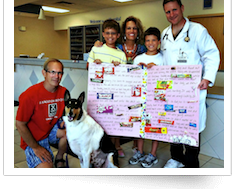Case Study: Feline Allergic Bronchitis (Feline Asthma)
Written by: Elizabeth Hines, 3rd year ISU veterinary medicine student • 2019 Scholar
History
Sparta is a 4-year-old, male-neutered, orange, domestic shorthair cat who presented to IVS as a triage (medical emergency) for respiratory distress. His owner reported that Sparta had been lethargic, refusing treats, and slightly ataxic (stumbling around). His symptoms started that morning.
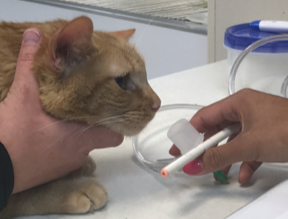
Sparta receiving oxygen when he presented as a triage.
Physical Exam: The Abnormal
Sparta’s temperature was slightly elevated at 102.9°F (normal temperature for cats is 100-102.5°F), likely due to stress. He was panting, which is not normal for cats and a sign of breathing trouble. When Dr. Mangus listened to Sparta’s lungs, she found that Sparta had decreased thoracic auscultation on the right side. This finding meant that something was dampening the sound of his breathing on the right side compared to the left, such as fluid or a mass. Dr. Mangus performed a T-FAST (thoracic focused assessment with sonography for trauma, triage, and tracking), or an ultrasound of the chest, to see if she could identify a cause for his respiratory distress and decreased lung sounds. B-lines were present on thoracic ultrasound, which is a sign of fluid in the chest (also known as pulmonary edema).

Dr. Mangus pointing out B-lines (bright, radiating lines that look like lightning rods) on thoracic ultrasound.
Diagnostics
(1) Bloodwork (complete blood count (CBC) and serum chemistry)
Why CBC? This test reports the number and maturity of red blood cells, white blood cells (WBCs), and platelets. We were specifically interested in the WBC for Sparta, as a high WBC is a sign of infection.
Why chemistry? This test is an overall assessment of organ function. It includes values for the liver and kidneys, as well as measurements of electrolytes, minerals, proteins, cholesterol, bilirubin, and glucose. The serum chemistry provided a general picture of Sparta’s health and helped us determine if something outside the lungs was a problem.
Results of CBC and chemistry: No significant findings
(2) Feline NT-proBNP SNAP test
Why? This test screens for heart disease in cats. Because of Sparta’s increased respiratory effort and fluid in his chest, we were concerned he had heart disease.
Results: Normal
(3) Thoracic radiographs
Why? Thoracic radiographs depict Sparta’s heart and lungs. The size of the heart can be measured; an enlarged heart size suggests disease. The appearance of the lungs on the radiograph can help us pinpoint where the problem is in the lungs and what it may be.
Results: Sparta’s heart was a normal size, but there was material in and surrounding the bronchi and bronchioles of his lungs. This material was plugging up his airways and preventing the passage of air into his lungs. His lungs were also hyperinflated, which was a consequence of trying to overcome the obstruction to breathe.

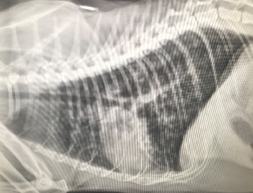
(4) Bronchoalveolar lavage (BAL)
Why? The BAL allowed us to sample the material in Sparta’s lungs, so we could diagnose and treat him appropriately.
How does it work? This procedure, involves pushing a bronchoscope, or a probe with a camera on the end, through the airway. The probe progresses from the mouth, past the larynx, into the trachea, and then into one of the bronchi. These structures are visualized as the camera progresses to the bronchi, so we can see if any abnormalities are present. When the bronchus is reached, a small amount of fluid is discharged into the lungs and immediately suctioned back up. Samples were submitted to ISU for bacterial culture and for evaluation of the cells present in the lavage fluid (cytology).
Results of lavage culture: No bacterial growth.
Results of lavage cytology: Red blood cells and white blood cells (mainly neutrophils and macrophages with a small amount of eosinophils) were identified. These results mean Sparta had mild-moderate inflammation with evidence of prior hemorrhage in his lungs.
Sparta. The small white circles throughout his lungs are the inflamed small airways.

The arrows show the path of the probe in a BAL. Image source: Merck Veterinary Manual.
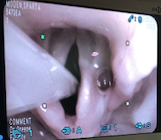
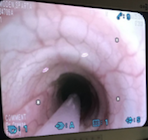
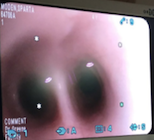
Pictures from Sparta’s BAL. The left picture shows the probe passing through the larynx. The middle picture shows the probe in the trachea, and the right picture shows the probe at the bifurcation of the two bronchi. The probe was passed into one of the dark holes (bronchus) to lavage the lung.

Sparta’s lavage fluid under the microscope. Yellow circle = neutrophil. Orange circle = macrophage. Blue circle = red blood cell. The main cells seen in his sample were neutrophils and macrophages (types of white blood cells), which indicate inflammation. The red blood cells mean Sparta had blood in his lungs as well.
Diagnosis
 ALLERGIC BRONCHITIS (FELINE ASTHMA)
ALLERGIC BRONCHITIS (FELINE ASTHMA)
What is it? Similar to humans, cats can have asthma. For unknown reasons, the cells lining the lower respiratory tract (bronchioles) become sensitized to a particular inhaled allergen. When the allergen is inhaled, it triggers an inflammatory response, causing constriction of the lower airways, recruitment of inflammatory cells to these airways, and mucus accumulation. The result is respiratory distress. It is estimated that 1-4% of cats have asthma, and in most cases the allergen is not known.
The bronchioles of an asthmatic cat are thickened and plugged with mucus, making it difficult for air to pass into the lungs. Image source: Cornell University.
Treatment
Short-term: Albuterol (administered via AeroKat Inhaler). Albuterol is a bronchodilator, which means it helps to open the bronchioles (lower airways). This medication was prescribed to help Sparta breathe better while his test results were pending. Because it did not address the underlying cause of Sparta’s respiratory signs (inflammation), albuterol was not suitable as a single, long-term treatment for Sparta’s asthma.
Long-term: Fluticasone proprionate. Fluticasone proprionate is a corticosteroid. Steroids inhibit inflammation, so this medication prevents Sparta’s sensitive airways from igniting an inflammatory response and obstructing his breathing.
Sparta Today
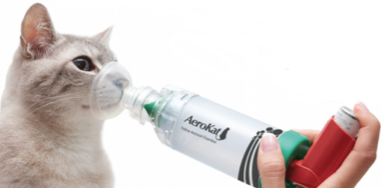
Sparta improved after starting the albuterol. He was no longer panting, and his lung sounds were mild. He is now transitioning to his steroid. The plan is to recheck his radiographs in 3 weeks to evaluate whether he responds to the medication. Feline asthma cannot be cured, but the prognosis is good with medical management and careful monitoring. Sparta seems to be happy he is feeling better, and we are happy he is too!
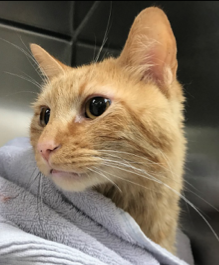
Inhaler designed for asthmatic cats that Sparta used (yes, cats have asthma inhalers too!). Image source: Trudell Medical International.
References
- Cornell Feline Health Center. Cornell University College of Veterinary Medicine. (2014). Feline asthma: what you need to know. Retrieved August 17, 2019, from https://www.vet.cornell.edu/departments-centers-and-institutes/cornell-feline-health-center/health-information/feline-health-topics/feline-asthma-what-you-need-know.
- Devine, Craig. (2011). How to do bronchoalveolar lavage. British Small Animal Veterinary Congress 2011. Retrieved August 17, 2019, from https://www.vin.com/doc/?id=4823302.
- Kuehn, Ned. (2018). Introduction to lung and airway disorders of cats. Merck Veterinary Manual. Retrieved August 17, 2019, from https://www.merckvetmanual.com/cat-owners/lung-and-airway-disorders-of-cats/introduction-to-lung-and-airway-disorders-of-cats?query=Feline%20asthma
- Trudell Medical International. (2015). AeroKat Feline Asthma Chamber: feline asthma. Retrieved August 17, 2019, from https://www.trudellmed.com/sites/default/files/inline-files/aerokat-dosing-information.pdf.
- University of Illinois College of Veterinary Medicine. (2013). Imaging anatomy: feline thorax example 3. Retrieved August 17, 2019, from https://vetmed.illinois.edu/imaging_anatomy/feline/thorax/ex03/ex03.html.



